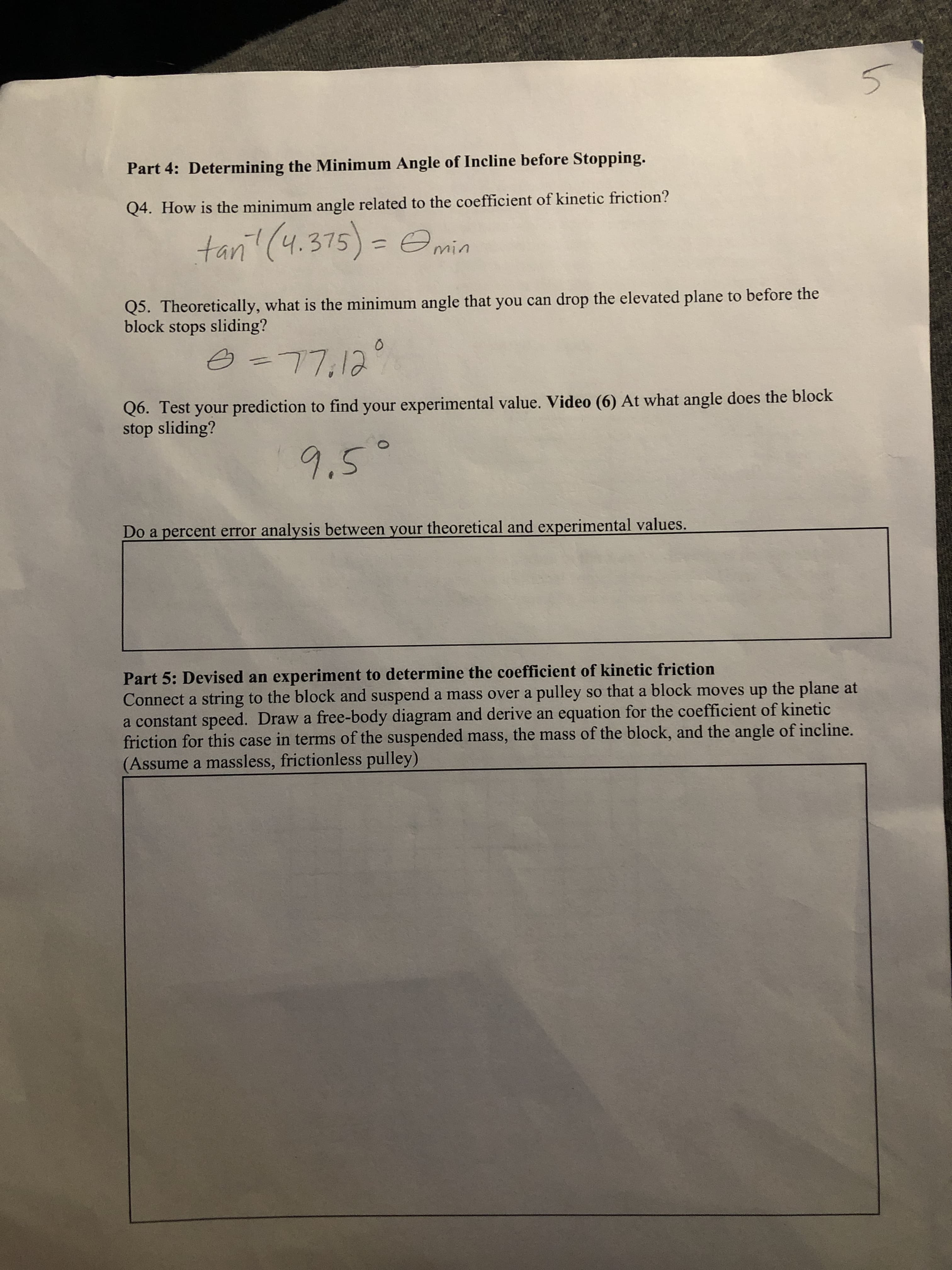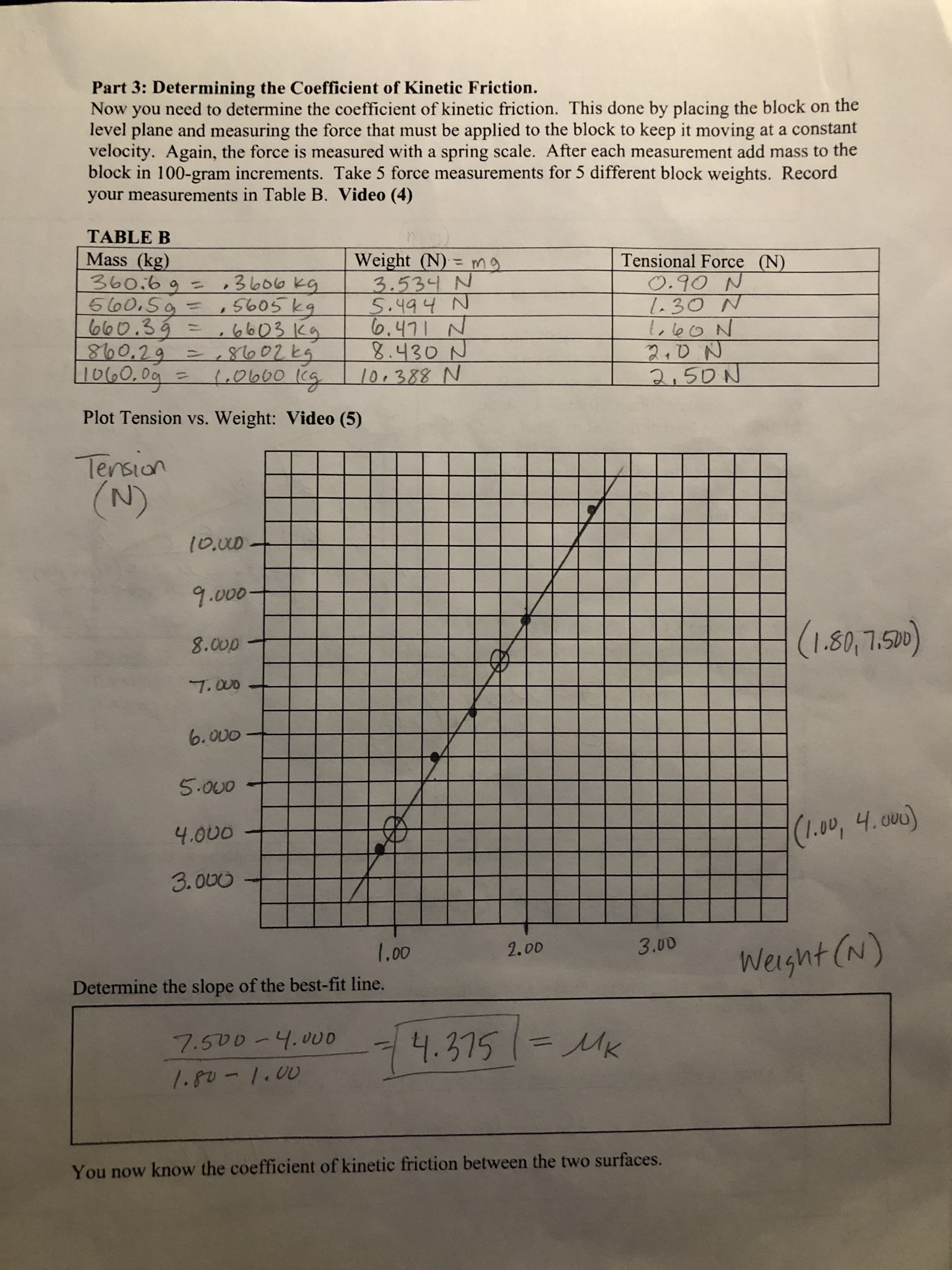Part 4: Determining the Minimum Angle of Incline before Stopping. Q4. How is the minimum angle related to the coefficient of kinetic friction? tan' (4.375)-emin Q5. Theoretically, what is the minimum angle that you can drop the elevated plane to before the block stops sliding? -77,12° Q6. Test your prediction to find your experimental value. Video (6) At what angle does the block stop sliding? 9.5°
Part 4: Determining the Minimum Angle of Incline before Stopping. Q4. How is the minimum angle related to the coefficient of kinetic friction? tan' (4.375)-emin Q5. Theoretically, what is the minimum angle that you can drop the elevated plane to before the block stops sliding? -77,12° Q6. Test your prediction to find your experimental value. Video (6) At what angle does the block stop sliding? 9.5°
International Edition---engineering Mechanics: Statics, 4th Edition
4th Edition
ISBN:9781305501607
Author:Andrew Pytel And Jaan Kiusalaas
Publisher:Andrew Pytel And Jaan Kiusalaas
Chapter7: Dry Friction
Section: Chapter Questions
Problem 7.73P: The normal pressure acting on the disk of the sander is given by p=(4/3)+(r2/6), where p is the...
Related questions
Question
I am working on a Friction lab for my physics class, I will attach my data and graphs.
My experimental coefficient of kinetic friction is 4.375, which gives me a minimum angle (theta) = 77 degrees, which is really far off (experimentally 9.5 degrees). Have I done something incorrectly? The data is from my instructor (through a video).
Thank you.

Transcribed Image Text:Part 4: Determining the Minimum Angle of Incline before Stopping.
Q4. How is the minimum angle related to the coefficient of kinetic friction?
tani! (4.375)
%3D
Q5. Theoretically, what is the minimum angle that you can drop the elevated plane to before the
block stops sliding?
Q6. Test your prediction to find your experimental value. Video (6) At what angle does the block
stop sliding?
.5
Do a percent error analysis between your theoretical and experimental values.
Part 5: Devised an experiment to determine the coefficient of kinetic friction
Connect a string to the block and suspend a mass over a pulley so that a block moves up the plane at
a constant speed. Draw a free-body diagram and derive an equation for the coefficient of kinetic
friction for this case in terms of the suspended mass, the mass of the block, and the angle of incline.
(Assume a massless, frictionless pulley)

Transcribed Image Text:Part 3: Determining the Coefficient of Kinetic Friction.
Now you need to determine the coefficient of kinetic friction. This done by placing the block on the
level plane and measuring the force that must be applied to the block to keep it moving at a constant
velocity. Again, the force is measured with a spring scale. After each measurement add mass to the
block in 100-gram increments. Take 5 force measurements for 5 different block weights. Record
your measurements in Table B. Video (4)
TABLE B
Mass (kg)
Weight (N) = mg
3.534 N
5.494N
Tensional Force (N)
660.39=
860.29=,8602 kg
|1060,0g=
8.430 N
NOの1
%3D
Plot Tension vs. Weight: Video (5)
Tension
(N)
1.00
2.00
Weight (N)
100
Determine the slope of the best-fit line.
-4.375
MK
You now know the coefficient of kinetic friction between the two surfaces.
Expert Solution
This question has been solved!
Explore an expertly crafted, step-by-step solution for a thorough understanding of key concepts.
This is a popular solution!
Trending now
This is a popular solution!
Step by step
Solved in 3 steps with 3 images

Knowledge Booster
Learn more about
Need a deep-dive on the concept behind this application? Look no further. Learn more about this topic, mechanical-engineering and related others by exploring similar questions and additional content below.Recommended textbooks for you

International Edition---engineering Mechanics: St…
Mechanical Engineering
ISBN:
9781305501607
Author:
Andrew Pytel And Jaan Kiusalaas
Publisher:
CENGAGE L

International Edition---engineering Mechanics: St…
Mechanical Engineering
ISBN:
9781305501607
Author:
Andrew Pytel And Jaan Kiusalaas
Publisher:
CENGAGE L